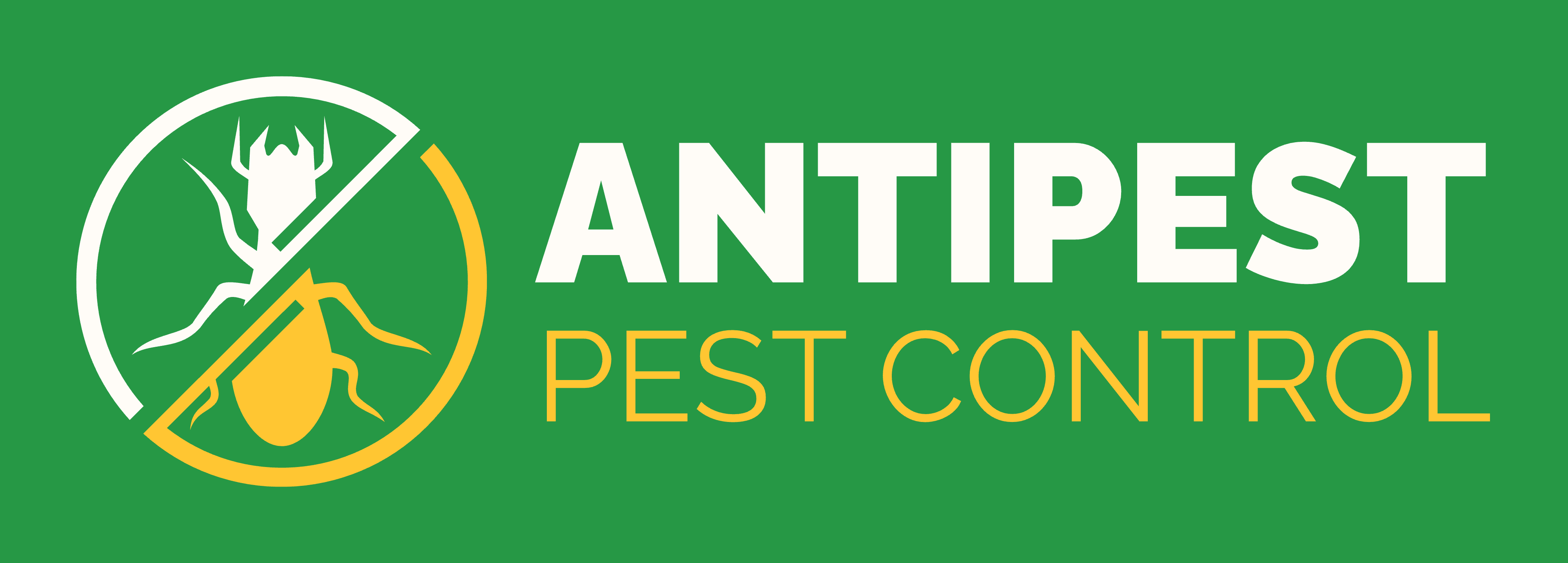Have you ever been in your kitchen or tending to your houseplants and noticed tiny flying insects hovering around? Chances are, you’ve wondered whether you’re dealing with gnats or fruit flies. The mix-up is common because both pests are small, quick, and equally annoying. But knowing the difference is essential, Gnats vs Fruit Flies may look alike at first glance, yet they live, breed, and infest in very different ways.While fruit flies are usually found buzzing around overripe or fermenting fruit, gnats are more likely to hang out near damp soil, drains, or decaying organic matter.
Misidentifying them can leave your control efforts ineffective. That’s why in this guide, we’ll break down Gnats vs Fruit Flies, highlighting how to identify them, their habits, and the most effective ways to get rid of an infestation. By the end, you’ll know exactly how to win the battle of Gnats vs Fruit Flies in your home.
Table of Contents
Why Comparing Gnats vs Fruit Flies Matters?
Confusing gnats with fruit flies is one of the most common mistakes homeowners make. While both appear to be nuisances, their preferred habitats, breeding grounds, and treatment methods differ. Understanding gnats vs fruit flies is essential for:
- Choosing the right trap or control method.
- Preventing recurring infestations in kitchens or gardens.
- Protecting food safety and indoor hygiene.
- Avoiding unnecessary pest control expenses.
Why It’s Important to Distinguish Gnats vs Fruit Flies
| Factor | Gnats | Fruit Flies |
| Habitat | Damp soil, houseplants, drains | Fermenting or rotting fruit |
| Main food source | Organic debris, mold, fungus | Overripe fruit, sugary liquids |
| Common indoors | Near plants, windows, sinks | Kitchen, trash cans, fruit bowls |
| Best treatment | Soil drying, sticky traps | Apple cider vinegar traps, cleaning food |
Gnat vs Fruit Fly : How to Spot the Difference
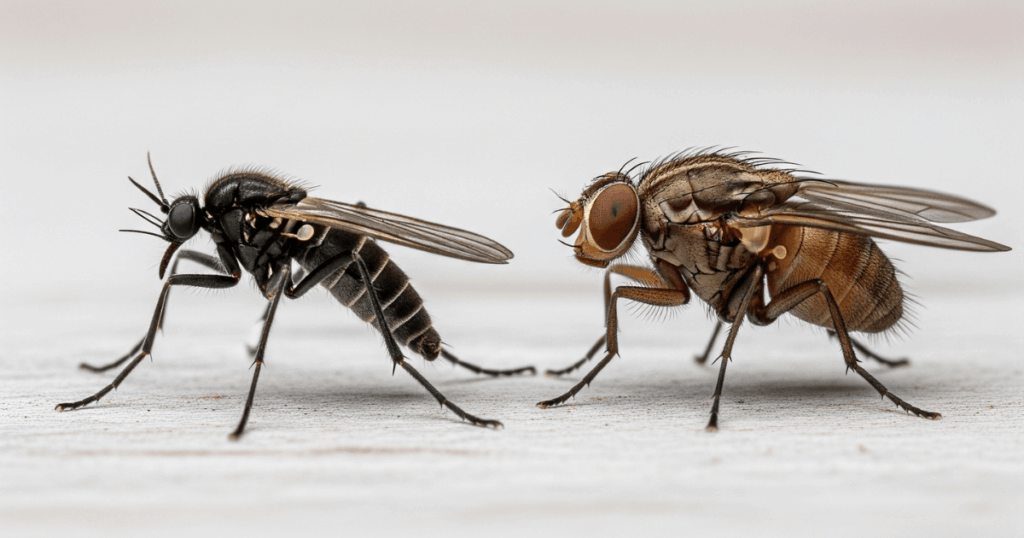
Identifying Gnats vs Fruit Flies correctly is essential for effective pest management. These tiny insects may look similar but have distinct features and behaviors that set them apart.
- Gnatshave slender bodies and long legs; fruit flies are rounder with shorter legs.
- Fruit flies have prominent red or dark eyes; gnats’ eyes are less noticeable.
- Gnats fly in erratic, unpredictable patterns; fruit flies move smoothly in circles.
- You will find gnats around moist soil and plants; fruit flies prefer fermenting fruits and kitchen waste.
- Knowing these traits helps distinguish Gnats vs Fruit Flies quickly in any setting.
| Feature | Gnats | Fruit Flies |
| Body Shape | Slender, mosquito-like | Rounded, squat |
| Eye Color | Less noticeable, usually dark | Prominent red or dark eyes |
| Flight Pattern | Erratic, irregular swarming | Smooth, circular flying |
| Preferred Habitat | Moist soil, potted plants | Ripe fruits, kitchen waste |
| Typical Location in House | Near indoor plants | Around fruit bowls, garbage |
The above distinctions in Gnats vs Fruit Flies provide practical ways to identify which insect you are dealing with, enabling targeted treatment and faster relief.
Key Difference Between Gnats vs Fruit Flies
Understanding physical differences is the first step in determining whether you’re dealing with gnats or fruit flies.
What does a gnat look like? – Appearance of Gnats
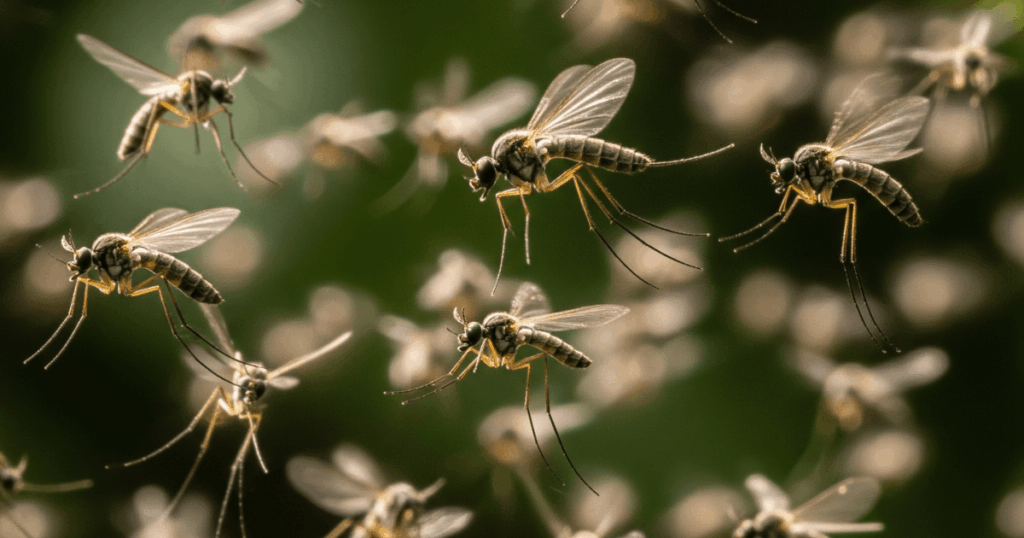
Gnats are slender, mosquito‑like insects with long legs and antennae. They may appear gray or black, often hovering near soil or damp areas indoors.
What does a fruit fly look like? – Appearance of Fruit Flies
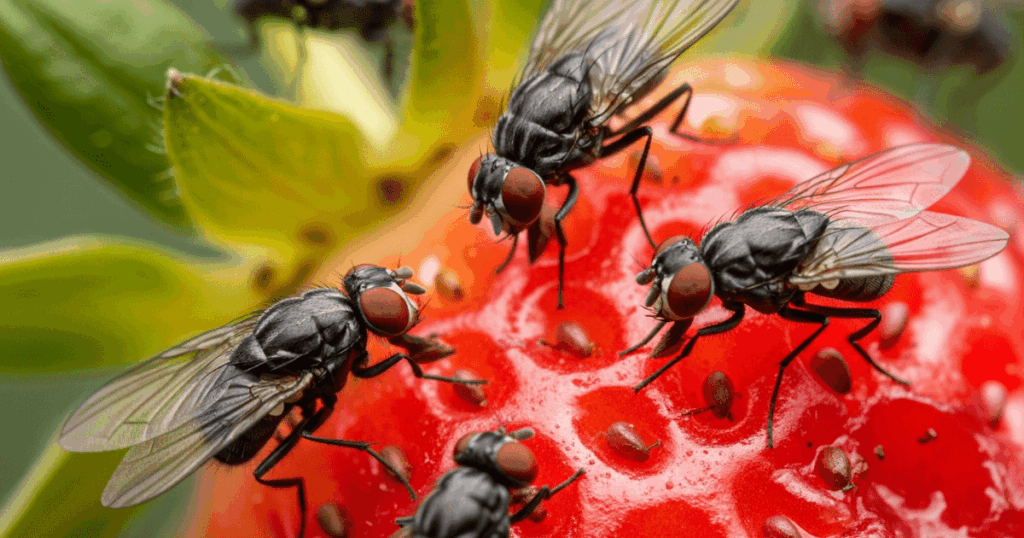
Fruit flies have short bodies, distinctive red eyes, and tan or brown coloring. They are usually rounder and swarm near fruit or sweet drinks.
Identification Markers for Gnats vs Fruit Flies
| Feature | Gnats | Fruit Flies |
| Body Shape | Thin, mosquito-like | Round, stocky |
| Eye Color | Black or neutral | Often bright red |
| Common Size | 1/8 inch | 1/8 inch |
| Preferred Spot | Soil, drains, dampness | Fruit bowls, trash, fermenting food |
Habitats: Where Do Gnats vs Fruit Flies Thrive?
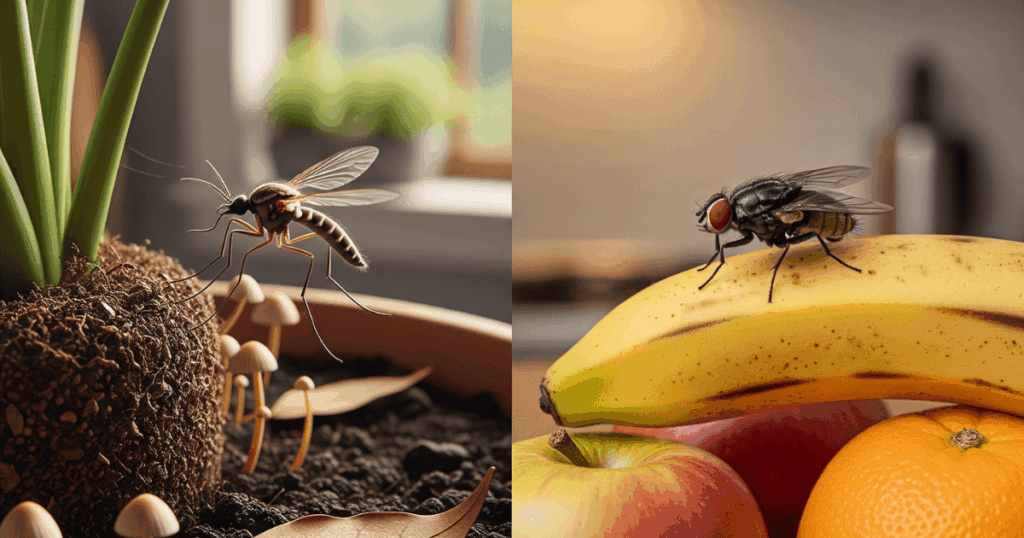
Knowing where each pest prefers to live will help determine whether your issue is with gnats or fruit flies.
Where Gnats Live?
Gnats are heavily associated with moisture. They reproduce in houseplant soil, clogged drains, garbage disposals, open trash bins, or areas with water leaks.
Where Fruit Flies Live
Fruit flies prefer decaying organic matter, including bananas, apples, peaches, and other sugary produce. They thrive in kitchens with exposed fruits and fermenting liquids.
Habits of Each Insect
- Gnats: Often fly in erratic swarms near windows or potted plants.
- Fruit Flies: Hover over kitchen counters, fruit baskets, or drains when food remnants are present.
Breeding and Life Cycle Differences Between Gnats vs Fruit Flies
Another important factor in the gnats vs fruit flies comparison is how they reproduce and how fast they multiply.
Life Cycle of Gnats
- Eggs hatch in moist soil or organic matter.
- Larvae feed on fungus and decayed plants.
- Adults live about one week but reproduce quickly.
Life Cycle of Fruit Flies
- Females lay eggs in overripe fruit.
- Larvae feed on yeast and sugar.
- Adults live up to 30 days, producing hundreds of offspring.
Breeding Overview of Gnats vs Fruit Flies
| Stage | Gnats | Fruit Flies |
| Egg location | Soil, organic debris | Rotten/fermenting fruit |
| Larvae diet | Fungus, mold, roots | Yeast, sugary liquids |
| Lifespan | Up to 1 week | Up to 30 days |
| Infestation speed | Moderate | Very rapid in warm kitchens |
“Want a cleaner, bug-free space? Discover expert tips on how to get rid of gnats fast.”
How to Get Rid of Gnats vs Fruit Flies?
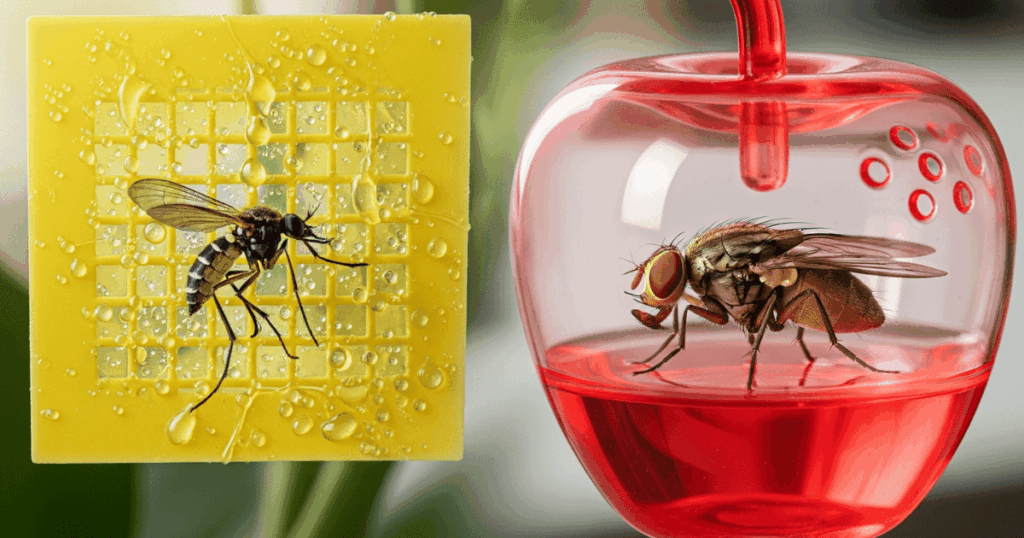
Once you’ve identified which insect is pestering your home, use the targeted solution. Trying to handle gnats as if they were fruit flies (and vice versa) often leads to frustration.
How to Get Rid of Gnats
- Allow houseplant soil to dry before watering.
- Use sticky traps near planters and windows.
- Clean drains with boiling water and baking soda.
- Avoid over‑watering or leaving standing water indoors.
How to Get Rid of Fruit Flies
- Store fruit in the refrigerator or covered containers.
- Use apple cider vinegar traps with a drop of dish soap.
- Rinse beverage bottles and cans before disposal.
- Take out kitchen garbage regularly.
Steps to Eliminate Gnats vs Fruit Flies
| Method | Best for Gnats | Best for Fruit Flies |
| Soil drying | Yes | No |
| Vinegar trap | Limited effect | Highly effective |
| Sticky traps | Effective | Somewhat effective |
| Drain cleaning | Very effective | Somewhat effective |
| Proper food storage | Helps with drains and garbage | Essential |
“Discover the surprising differences between red ants vs black ants – and learn which one you should really watch out for!”
Health Risks and Concerns for Gnats vs Fruit Flies
Though tiny, infestations of gnats vs fruit flies can create hygiene problems in households.
Risks with Gnats
Gnats don’t typically spread diseases humans suffer from but can contaminate soil and harm plant roots. Indoor gardeners often find gnat infestations damaging for plant health.
Risks with Fruit Flies
Fruit flies can carry bacteria from rotting foods and garbage, potentially contaminating countertops and fresh produce. Their presence in kitchens poses food-safety risks.
In short, gnats vs fruit flies highlight environmental concerns: gnats warn of moisture issues, while fruit flies indicate poor food hygiene.
How to Treat Gnats vs Fruit Flies?
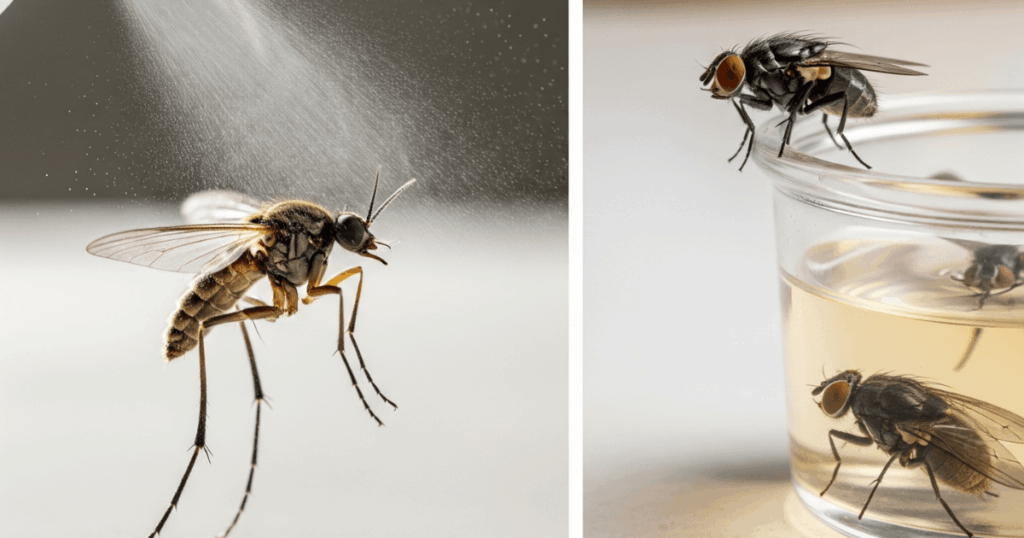
Treating Gnats vs Fruit Flies requires addressing their specific breeding environments and habits. Proper identification leads to more effective removal methods.
- Remove all overripe or rotting fruits that attract fruit flies.
- Use apple cider vinegar traps combined with soap to catch and kill fruit flies.
- Clean kitchen drains and garbage disposals to eliminate fruit fly breeding sites.
- Allow plant soil to dry out between watering to disrupt gnat larvae growth.
- Set yellow sticky traps near houseplants to trap adult gnats.
- Apply biological insecticides like nematodes or Bacillus thuringiensis (Bt) to control fungus gnats naturally.
- Maintain sanitation and moisture control to prevent both pests from returning.
| Treatment Method | Effective Against | How It Works |
| Fruit Removal | Fruit Flies | Eliminates breeding material |
| Vinegar Soap Trap | Fruit Flies | Attracts and drowns adults |
| Drain Cleaning | Fruit Flies | Removes organic residue and eggs |
| Soil Drying | Gnats | Kills larvae dependent on moisture |
| Sticky Traps | Gnats | Catches adult gnats before breeding |
| Biological Controls (Bt) | Gnats | Targets larvae without chemicals |
Following these treatment steps tailored to Gnats vs Fruit Flies will greatly improve chances of eliminating infestations and stopping new ones from developing.
Preventing Infestations of Gnats vs Fruit Flies in the Future
The best long‑term solution is prevention. Here are specific tips for gnats vs fruit flies avoidance in homes and kitchens.
Preventing Gnats
- Limit indoor moisture with dehumidifiers.
- Avoid letting plant soil remain soggy.
- Clean drains regularly using natural solutions.
Preventing Fruit Flies
- Refrigerate produce as soon as possible.
- Wash fruit immediately after purchase.
- Avoid leaving sugary residues and spills unattended.
By targeting their unique breeding environments, you reduce the risk of both pests thriving indoors.
Call the Professionals to Get Rid of Gnats vs Fruit Flies
Sometimes home treatments are not enough to control Gnats vs Fruit Flies infestations, and professional help becomes necessary. Experts can quickly identify the pest and apply targeted treatments for lasting results.
- Pest control professionals know the subtle differences between gnats and fruit flies.
- They use specialized insecticides and techniques unavailable to general consumers.
- Professionals locate hidden breeding areas beyond obvious spots, like deep drains or damp basements.
- Expert treatments come with follow-up visits to prevent recurring Gnats vs Fruit Flies problems.
- Hiring professionals saves time, reduces stress, and restores a pest-free home environment faster.
| Benefit | Home Remedies | Professional Pest Control |
| Identification Accuracy | Moderate | High |
| Treatment Effectiveness | Variable | Consistently effective |
| Access to Equipment | Limited | Advanced tools and chemicals |
| Follow-Up Services | Typically none | Included with service |
| Time and Effort | Requires persistent effort | Saves homeowner’s time and effort |
For comprehensive and hassle-free gnats and fruit flies removal and long-term pest prevention, trust the professionals at Antipest Office. Visit us at the Antipest Office, Our trained technicians use safe and effective methods to protect your home and business. For service bookings and consultations, call us at +91 9819018398 .
Professional intervention can be the best solution when Gnats vs Fruit Flies persist despite thorough at-home treatments.
Conclusion: Key Takeaways on Gnats vs Fruit Flies
The gnats vs fruit flies debate often confuses homeowners, leading to wasted time and ineffective solutions. These pests may look similar at a glance, but their habitats, food preferences, breeding habits, and control methods differ in crucial ways. Recognizing these differences helps you tackle each infestation with the right method: drying soil and cleaning drains for gnats, vinegar traps and improved food storage for fruit flies.
By keeping your home clean, ventilated, and free of open food sources, you’ll successfully win the gnats vs fruit flies battle and maintain a pest‑free environment.
What is the Difference Between Gnats vs Fruit Flies? – FAQs
What is the main difference between gnats vs fruit flies?
Gnats live in damp soil or drains, while fruit flies prefer rotting fruit and sugary liquids. Identifying the habitat quickly clarifies which pest you’re dealing with.
How do you identify gnats vs fruit flies indoors?
Gnats are thin and mosquito-like, while fruit flies have round bodies with red eyes. Check whether they swarm around plants or fruit bowls to confirm.
What attracts gnats vs fruit flies the most?
Gnats are attracted to moisture, fungus, and plant soil; fruit flies are drawn to fermenting fruits, vegetables, and sugary kitchen residues. Identification depends on the source.
Where do gnats vs fruit flies come from inside homes?
Gnats emerge from moist soil, clogged drains, and garbage bins. Fruit flies typically come from overripe produce, trash cans, and spilled beverages left uncovered.
How can you trap gnats vs fruit flies effectively?
Use yellow sticky traps or soil drying for gnats, while vinegar traps work best against fruit flies near food or fermenting organic matter.
Are gnats and fruit flies harmful to humans?
Fruit flies can contaminate food, posing hygiene concerns, while gnats are generally nuisance pests but may harm plants by feeding on root systems when overpopulated.
What kills gnats vs fruit flies quickly at home?
Gnats can be managed using soil drying, sticky traps, or drain cleaning. Fruit flies are eliminated effectively with vinegar traps and improved kitchen food storage.
How long do gnats vs fruit flies live?
Gnats usually live about one week, breeding in damp soil, while fruit flies can live up to 30 days and reproduce rapidly inside kitchens.
Do gnats vs fruit flies require different prevention methods?
Yes, gnats are prevented by controlling soil moisture and drains, while fruit fly prevention depends on proper food storage, refrigeration, and sanitation practices.
Why is it important to distinguish gnats vs fruit flies?
Treating them differently ensures effective control, gnats require drying soil and drain cleaning, while fruit flies demand food management and vinegar-based trapping solutions.

